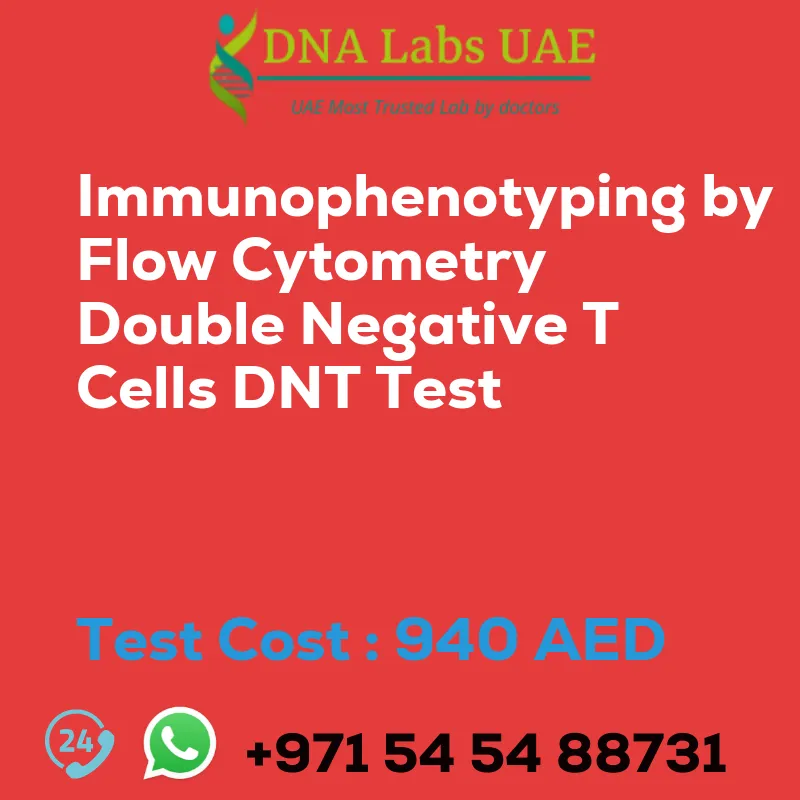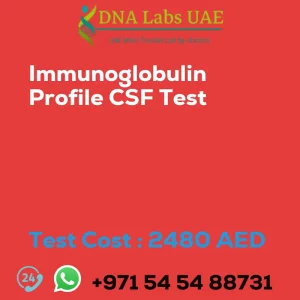IMMUNOPHENOTYPING BY FLOW CYTOMETRY DOUBLE NEGATIVE T CELLS DNT Test
At DNA Labs UAE, we offer the IMMUNOPHENOTYPING BY FLOW CYTOMETRY DOUBLE NEGATIVE T CELLS DNT Test to analyze and characterize different cell populations based on their surface markers. This test is commonly used in the diagnosis of autoimmune disorders.
Test Details
The IMMUNOPHENOTYPING BY FLOW CYTOMETRY DOUBLE NEGATIVE T CELLS DNT Test is performed using flow cytometry, a technique that allows us to analyze cells based on their fluorescence intensity and pattern. Specifically, this test focuses on Double Negative T cells (DNT), a subset of T cells that lack the expression of both CD4 and CD8 co-receptors on their surface.
Test Components
The cost of the IMMUNOPHENOTYPING BY FLOW CYTOMETRY DOUBLE NEGATIVE T CELLS DNT Test is AED 940.0. The test requires a sample condition of 3 mL (2 mL min.) whole blood in 1 Lavender Top (EDTA) tube and 3 mL (2 mL min.) whole blood in 1 Green Top (Sodium Heparin) tube. The samples should be shipped immediately at 18-22°C and should not be refrigerated or frozen. Please specify the time, date, and clinical details on the test request form.
Report Delivery
The sample is collected daily by 9 am and the report will be delivered on the next working day.
Method
The IMMUNOPHENOTYPING BY FLOW CYTOMETRY DOUBLE NEGATIVE T CELLS DNT Test is performed using flow cytometry.
Test Type
This test is used for the diagnosis of autoimmune disorders.
Doctor
This test is typically requested by pediatricians.
Test Department
The IMMUNOPHENOTYPING BY FLOW CYTOMETRY DOUBLE NEGATIVE T CELLS DNT Test is conducted in the Flow Cytometry department.
Pre Test Information
Please provide a brief clinical history before the test.
Understanding the Test
Immunophenotyping by flow cytometry is a technique used to analyze and characterize different cell populations based on their surface markers. In the case of the IMMUNOPHENOTYPING BY FLOW CYTOMETRY DOUBLE NEGATIVE T CELLS DNT Test, the focus is on Double Negative T cells (DNT) that lack the expression of both CD4 and CD8 co-receptors on their surface.
The test involves the following steps:
- Sample preparation: Blood or tissue samples containing T cells are collected from the patient or experimental model. The cells are then isolated using appropriate techniques such as density gradient centrifugation.
- Antibody staining: The isolated T cells are incubated with a panel of fluorescently labeled antibodies specific to various cell surface markers. In the case of DNT cells, the panel may include antibodies against CD3, CD4, and CD8.
- Flow cytometry analysis: The stained cells are passed through a flow cytometer, which detects and measures the fluorescence emitted by each individual cell as it passes through the laser beam. The flow cytometer can distinguish different cell populations based on their fluorescence intensity and pattern.
- Data analysis: The flow cytometry data is analyzed using specialized software to identify and quantify the different cell populations. In the case of DNT cells, the analysis would focus on identifying the CD3+CD4-CD8- population.
Immunophenotyping of DNT cells can provide valuable information about the immune system and its response to various diseases and conditions. For example, an increased presence of DNT cells has been observed in autoimmune diseases, such as systemic lupus erythematosus (SLE), suggesting their potential role in the pathogenesis of these conditions.
It is important to note that the specific antibody panel and analysis parameters may vary depending on the research or diagnostic goals of the study. Additionally, immunophenotyping can be performed on other cell types as well, not just DNT cells.
| Test Name | IMMUNOPHENOTYPING BY FLOW CYTOMETRY DOUBLE NEGATIVE T CELLS DNT Test |
|---|---|
| Components | |
| Price | 940.0 AED |
| Sample Condition | 3 mL (2 mL min.) whole blood in 1 Lavender Top (EDTA) tubeAND 3 mL (2 mL min.) whole blood in 1 Green Top (Sodium Heparin) tube. Ship immediately at 18\u0192??22?\u00f8C. DO NOT REFRIGERATE OR FREEZE. Specify time, date and clinical details on test request form. |
| Report Delivery | Sample Daily by 9 am; Report Next Working day |
| Method | Flow Cytometry |
| Test type | Autoimmune Disorders |
| Doctor | Pediatrician |
| Test Department: | FLOW CYTOMETRY |
| Pre Test Information | Give brief clinical history. |
| Test Details |
Immunophenotyping by flow cytometry is a technique used to analyze and characterize different cell populations based on their surface markers. One specific cell population that can be analyzed using this technique is Double Negative T cells (DNT). Double Negative T cells refer to a subset of T cells that lack the expression of both CD4 and CD8 co-receptors on their surface. These cells are also known as CD4-CD8- T cells or DN T cells. To perform an immunophenotyping analysis of DNT cells, the following steps are typically followed: 1. Sample preparation: Blood or tissue samples containing T cells are collected from the patient or experimental model. The cells are then isolated using appropriate techniques such as density gradient centrifugation. 2. Antibody staining: The isolated T cells are incubated with a panel of fluorescently labeled antibodies specific to various cell surface markers. In the case of DNT cells, the panel may include antibodies against CD3, CD4, and CD8. 3. Flow cytometry analysis: The stained cells are passed through a flow cytometer, which detects and measures the fluorescence emitted by each individual cell as it passes through the laser beam. The flow cytometer can distinguish different cell populations based on their fluorescence intensity and pattern. 4. Data analysis: The flow cytometry data is analyzed using specialized software to identify and quantify the different cell populations. In the case of DNT cells, the analysis would focus on identifying the CD3+CD4-CD8- population. Immunophenotyping of DNT cells can provide valuable information about the immune system and its response to various diseases and conditions. For example, an increased presence of DNT cells has been observed in autoimmune diseases, such as systemic lupus erythematosus (SLE), suggesting their potential role in the pathogenesis of these conditions. It is important to note that the specific antibody panel and analysis parameters may vary depending on the research or diagnostic goals of the study. Additionally, immunophenotyping can be performed on other cell types as well, not just DNT cells. |








